Half way "Juno"
After the official extension last summer of the work of the Jupiter probe "Juno" until 2021, it turned out that half of its mission fell in December. And from the beginning of work in orbit in 2016, all new scientific results appear.

Cloud in the form of a dolphin on Jupiter, photo by NASA
According to the original plan, "Juno" was supposed to move from a 53-day intermediate orbit to a working one with a period of 14 days. However, the problem with helium boost valves caused the probe to remain in an intermediate 53-day orbit. Fortunately, its parameters were preselected such that the vehicle flew over various parts of the planet, albeit more slowly than the original plan.
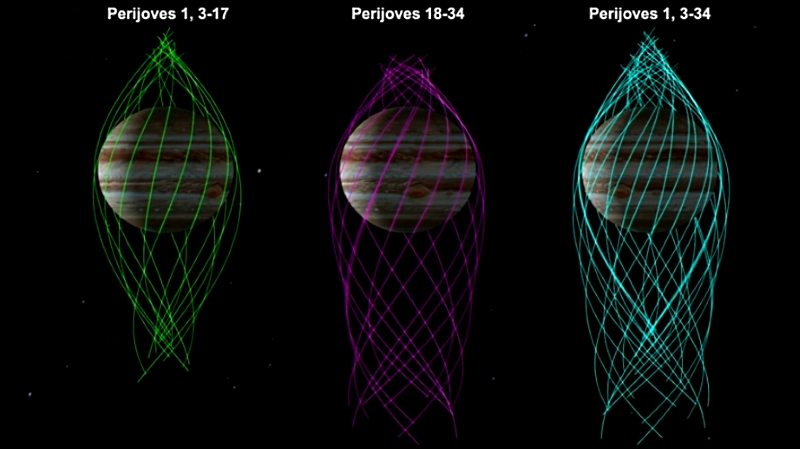
Image: NASA
After the seventeenth period (the lowest point of the orbit) "Juno" passed over the entire surface of Jupiter at intervals of 22.5 ° (green lines in the image on the left). This allowed us to create a three-dimensional map, albeit with a low resolution. The turns of the second half of the mission (purple lines in the center of the picture) will be located between the turns of the first half, which will increase the resolution of the card based on the aisles at 11.25 ° intervals. Also, the natural changes of the orbit will lead to the fact that the probe will pass closer to the north pole of Jupiter, and this is very successful, because this is where the most interesting magnetosphere is located.
First of all, "Juno" allowed to get a much better map of the magnetosphere. Strictly speaking, this was one of the main tasks of the apparatus.
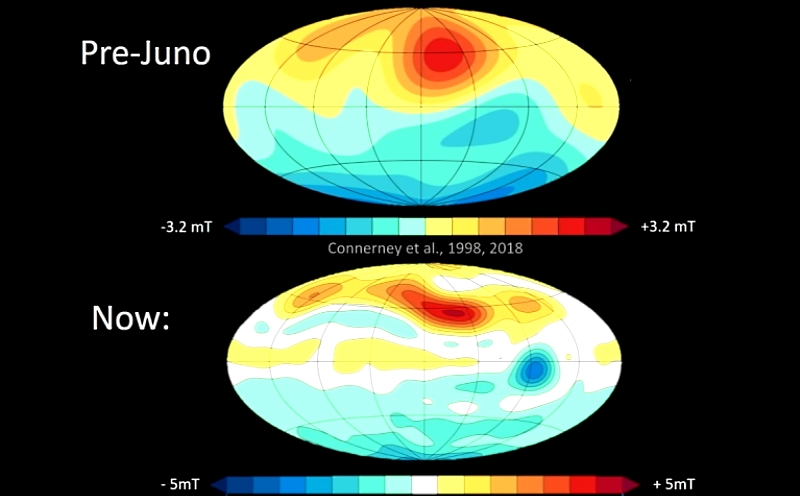
The map of the magnetic field to "Juno" (above) and according to her data, the image of NASA.
Before "Juno", Jupiter's magnetosphere was presented as an analog of the Earth, with marked north and south poles, only stronger. But this turned out to be completely different. In Jupiter, a band was found instead of a pole in the northern hemisphere, a “big blue spot”, practically the second south pole, but at the equator and a very simple structure of the magnetosphere in the southern hemisphere.
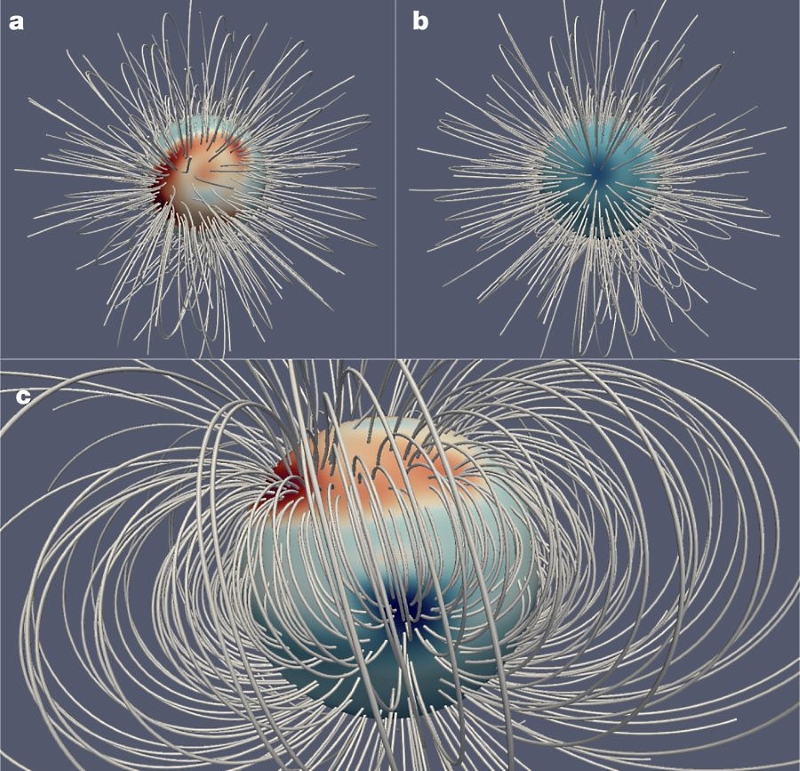
Map of the magnetic lines of Jupiter. A is a strip instead of the north pole, b is a simple south pole, c is a “big blue spot”, NASA / Nature image
Why is the magnetosphere so complicated? Already the first resultsshowed that Jupiter had something inside it that looked like a huge fuzzy core. Metallic hydrogen, which creates a magnetic field, can take complex forms, which are obviously responsible for the unusual magnetosphere.
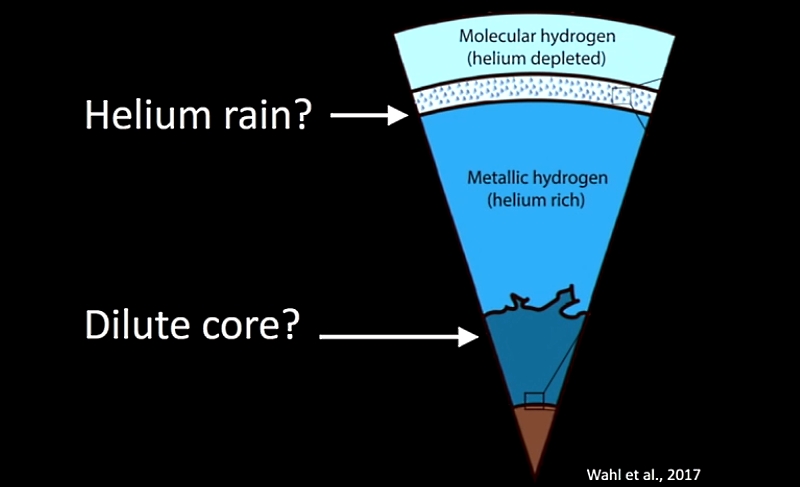
The alleged structure of Jupiter, NASA image
Curious results were obtained when observing radiation belts. First of all, it turned out that their intensity is lower than estimated. This is good news for "Juno" - the probe can work longer.
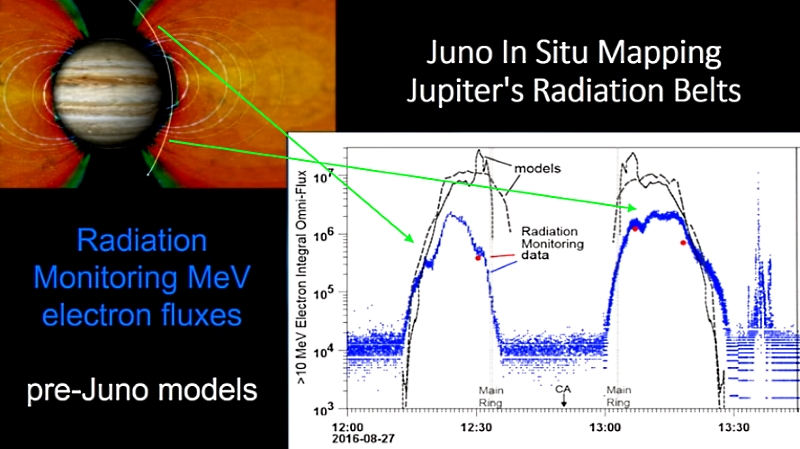
The trajectory of the device (left) and the measurement results in comparison with the calculated ones. NASA image
Also “Juno” discovered another radiation belt in Jupiter, located very close to the cloud level and consisting of atoms that once flew out of the Io volcanoes satellites of Jupiter.
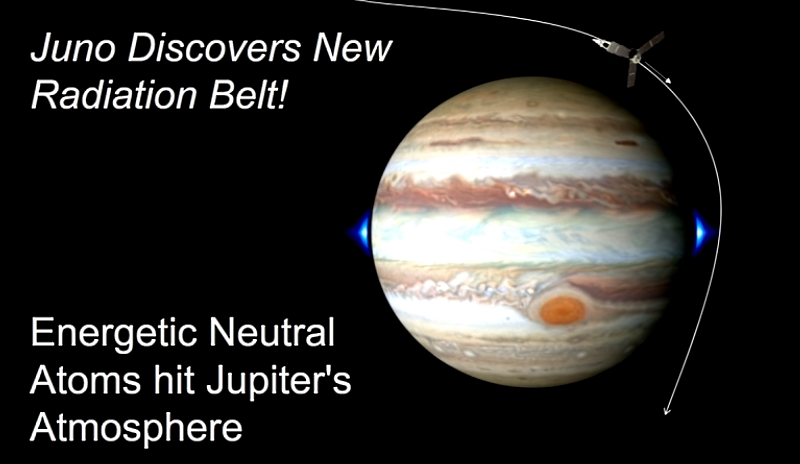
Another radiation belt, NASA image
The star sensor, whose main task is to determine the position of the apparatus by the stars, simultaneously solves several scientific problems at once.
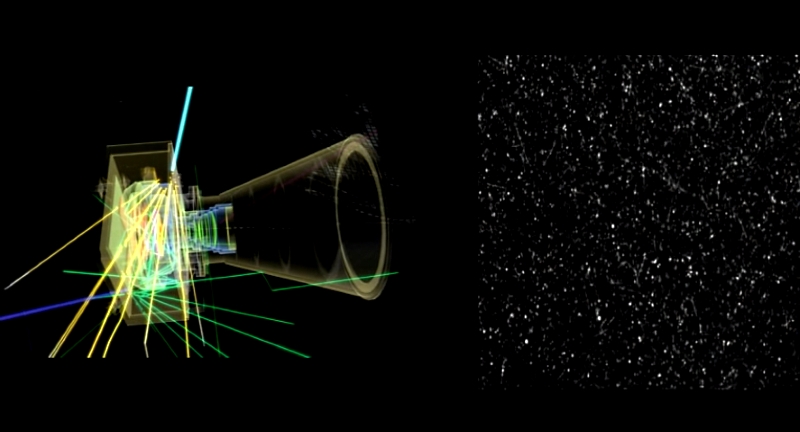
On the left: a star sensor circuit with noise animation, on the right - an image obtained from the matrix. Illustration of NASA
First, despite all the shielding, high-energy electrons make their way through the protection and leave their marks on the matrix in the form of "snow". The on-board computer copes with navigation by screening out this noise, but scientists use the degree of image illumination to measure the intensity of the radiation belts - the brightness of the illumination is calculated and the radiation situation through which the Juno flies is calculated on its basis.
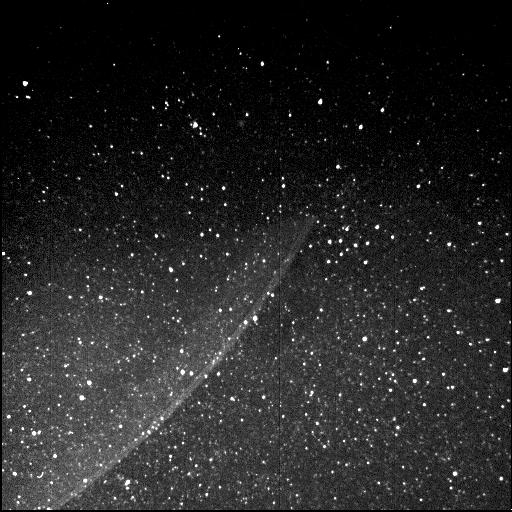
NASA image
Secondly, it was the star sensor that made the first photos of the ring of Jupiter from the inside. Pictured above is a photograph of the ring of Jupiter, taken from a latitude of 55 °. It is clearly seen that the ring has a structure.

NASA image
And this image is a photograph of the aurora from the closest distance, only 60 thousand kilometers above the clouds. The star sensor captured not only the complex structure of the aurora, but also one of the many Jupiter lightnings (the bright circle on the right-bottom). By the way, it was Juno that was able to determine the difference between lightning on Jupiter and Earth. The fact is that there are more lightning on Earth around the equator - the Sun heats the Earth more there, generating convection and thunderstorms. And on Jupiter, on the contrary, there are more lightning at the poles. Five times the distance of Jupiter from the Sun means that 1/25 of the solar energy falls to its share. But this is enough for the warm upper atmosphere to stop convection at the equator. But at the poles the atmosphere is stirred more actively, creating conditions for thunderstorms.
The Junocam camera exceeded the engineers' expectations - instead of 7 turns, it already works 17 and shows no signs of wear. And thanks to her, we get not only beautiful photographs (in general, its main purpose is public relations and popularization), but also data for future scientific work. For example, of interest is the haze at high latitudes - what particles does it consist of?

And the white stripes in this photo are “raised” storms (with side lighting, they cast a shadow, which means they are located above the neighboring clouds), the physics of the appearance of which is also not yet clear.

And, of course, images from Junocam make it possible to get absolutely fantastic pictures of the span over the planet.
And visible cyclones in the near-polar region get a three-dimensional structure according to the infrared instrument JRAM
18 periyovy already tomorrow, February 12, waiting for new beautiful photos and interesting scientific data.

Cloud in the form of a dolphin on Jupiter, photo by NASA
Nasty problem
According to the original plan, "Juno" was supposed to move from a 53-day intermediate orbit to a working one with a period of 14 days. However, the problem with helium boost valves caused the probe to remain in an intermediate 53-day orbit. Fortunately, its parameters were preselected such that the vehicle flew over various parts of the planet, albeit more slowly than the original plan.

Image: NASA
After the seventeenth period (the lowest point of the orbit) "Juno" passed over the entire surface of Jupiter at intervals of 22.5 ° (green lines in the image on the left). This allowed us to create a three-dimensional map, albeit with a low resolution. The turns of the second half of the mission (purple lines in the center of the picture) will be located between the turns of the first half, which will increase the resolution of the card based on the aisles at 11.25 ° intervals. Also, the natural changes of the orbit will lead to the fact that the probe will pass closer to the north pole of Jupiter, and this is very successful, because this is where the most interesting magnetosphere is located.
More poles
First of all, "Juno" allowed to get a much better map of the magnetosphere. Strictly speaking, this was one of the main tasks of the apparatus.

The map of the magnetic field to "Juno" (above) and according to her data, the image of NASA.
Before "Juno", Jupiter's magnetosphere was presented as an analog of the Earth, with marked north and south poles, only stronger. But this turned out to be completely different. In Jupiter, a band was found instead of a pole in the northern hemisphere, a “big blue spot”, practically the second south pole, but at the equator and a very simple structure of the magnetosphere in the southern hemisphere.

Map of the magnetic lines of Jupiter. A is a strip instead of the north pole, b is a simple south pole, c is a “big blue spot”, NASA / Nature image
Why is the magnetosphere so complicated? Already the first resultsshowed that Jupiter had something inside it that looked like a huge fuzzy core. Metallic hydrogen, which creates a magnetic field, can take complex forms, which are obviously responsible for the unusual magnetosphere.

The alleged structure of Jupiter, NASA image
Radiation
Curious results were obtained when observing radiation belts. First of all, it turned out that their intensity is lower than estimated. This is good news for "Juno" - the probe can work longer.

The trajectory of the device (left) and the measurement results in comparison with the calculated ones. NASA image
Also “Juno” discovered another radiation belt in Jupiter, located very close to the cloud level and consisting of atoms that once flew out of the Io volcanoes satellites of Jupiter.

Another radiation belt, NASA image
Multi-station camera
The star sensor, whose main task is to determine the position of the apparatus by the stars, simultaneously solves several scientific problems at once.

On the left: a star sensor circuit with noise animation, on the right - an image obtained from the matrix. Illustration of NASA
First, despite all the shielding, high-energy electrons make their way through the protection and leave their marks on the matrix in the form of "snow". The on-board computer copes with navigation by screening out this noise, but scientists use the degree of image illumination to measure the intensity of the radiation belts - the brightness of the illumination is calculated and the radiation situation through which the Juno flies is calculated on its basis.

NASA image
Secondly, it was the star sensor that made the first photos of the ring of Jupiter from the inside. Pictured above is a photograph of the ring of Jupiter, taken from a latitude of 55 °. It is clearly seen that the ring has a structure.

NASA image
And this image is a photograph of the aurora from the closest distance, only 60 thousand kilometers above the clouds. The star sensor captured not only the complex structure of the aurora, but also one of the many Jupiter lightnings (the bright circle on the right-bottom). By the way, it was Juno that was able to determine the difference between lightning on Jupiter and Earth. The fact is that there are more lightning on Earth around the equator - the Sun heats the Earth more there, generating convection and thunderstorms. And on Jupiter, on the contrary, there are more lightning at the poles. Five times the distance of Jupiter from the Sun means that 1/25 of the solar energy falls to its share. But this is enough for the warm upper atmosphere to stop convection at the equator. But at the poles the atmosphere is stirred more actively, creating conditions for thunderstorms.
Art and science
The Junocam camera exceeded the engineers' expectations - instead of 7 turns, it already works 17 and shows no signs of wear. And thanks to her, we get not only beautiful photographs (in general, its main purpose is public relations and popularization), but also data for future scientific work. For example, of interest is the haze at high latitudes - what particles does it consist of?

And the white stripes in this photo are “raised” storms (with side lighting, they cast a shadow, which means they are located above the neighboring clouds), the physics of the appearance of which is also not yet clear.

And, of course, images from Junocam make it possible to get absolutely fantastic pictures of the span over the planet.
And visible cyclones in the near-polar region get a three-dimensional structure according to the infrared instrument JRAM
Conclusion
18 periyovy already tomorrow, February 12, waiting for new beautiful photos and interesting scientific data.
